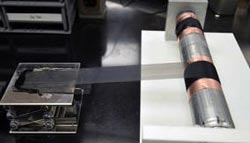Battery Design Gets Boost from Aligned Carbon Nanotubes

A sheet of aligned carbon nanotubes is rolled on a cylinder. Copyright Wiley-VCH Verlag GmbH & Co. KGaA. Reproduced with permission.<br>
The research, published online in Advanced Materials, shows the potential of manufactured sheets of aligned carbon nanotubes coated with silicon, a material with a much higher energy storage capacity than the graphite composites typically used in lithium ion batteries.
“Putting silicon into batteries can produce a huge increase in capacity—10 times greater,” said Dr. Philip Bradford, assistant professor of textile engineering, chemistry and science at NC State. “But adding silicon can also create 10 times the problems.”
One significant challenge in using silicon is that it swells as lithium ion batteries discharge. As the batteries cycle, silicon can break off from the electrode and float around (known as pulverization) instead of staying in place, making batteries less stable.
When the silicon-coated carbon nanotubes were aligned in one direction like a layer of drinking straws laid end to end, the structure allowed for controlled expansion so that the silicon is less prone to pulverization, said Xiangwu Zhang, associate professor of textile engineering, chemistry and science at NC State.
“There’s a huge demand for batteries for cell phones and electric vehicles, which need higher energy capacity for longer driving distances between charges,” Zhang said. “We believe this carbon nanotube scaffolding potentially has the ability to change the industry, although technical aspects will have to be worked out. The manufacturing process we’re using is scalable and could work well in commercial production.”
The research was supported by the Donors to the American Chemical Society Petroleum Research Fund.
Note to editors: An abstract of the paper follows.
“Aligned Carbon Nanotube-Silicon Sheets: A Novel Nano-architecture for Flexible Lithium Ion Battery Electrodes”
Published: Online Aug. 1 in Advanced Materials
Authors: Kun Fu, Ozkan Yildiz, Hardik Bhanushali, Yongxin Wang, Kelly Stano, Leigang Xue, Ziangwu Zhang, and Philip D. Bradford
Abstract: In the pursuit of high performance lithium ion batteries (LIBs), significant effort has been expended to explore high performance cathode and anode materials. Silicon has the greatest lithium storage capacity per unit mass, and is therefore one of the most promising potential candidates to replace graphite as the anode material in future generations of batteries. The main challenge in utilizing silicon comes from the structural failure induced by its large volume change (>300%) during electrochemical cycling, leading to capacity loss. New designs, in which silicon and carbon can act in a mutually beneficial way, so that silicon can fully contribute to the capacity while maintaining cyclic stability, are needed. With this in mind, this communication describes novel, binder-free, thin sheet anodes for LIBs using aligned carbon nanotube (CNT) based silicon films which were processed in a way that is conducive to future commercial production. The horizontal super-aligned CNT sheets provided high surface area and a porous structure to facilitate both the uniform chemical vapor deposition of silicon during fabrication and the electrochemical kinetics between the silicon and the electrolyte during use. The CNT-based silicon composite sheets had both high specific energy capacity and stable cycle performance. This work also revealed an interesting new mechanism of deformation for silicon coated CNT structures after electrochemical cycling. A spring-like deformation behavior of the aligned CNTs helped to explain the electrochemical stability of the crystalline silicon coatings. These findings will guide future work to optimize this unique nano-architecture for further increases in energy density and stability. This aligned CNT scaffold design may be extended to other anode and cathode materials utilized in thin and flexible LIBs.
Media Contact
More Information:
http://www.ncsu.eduAll latest news from the category: Materials Sciences
Materials management deals with the research, development, manufacturing and processing of raw and industrial materials. Key aspects here are biological and medical issues, which play an increasingly important role in this field.
innovations-report offers in-depth articles related to the development and application of materials and the structure and properties of new materials.
Newest articles

High-energy-density aqueous battery based on halogen multi-electron transfer
Traditional non-aqueous lithium-ion batteries have a high energy density, but their safety is compromised due to the flammable organic electrolytes they utilize. Aqueous batteries use water as the solvent for…

First-ever combined heart pump and pig kidney transplant
…gives new hope to patient with terminal illness. Surgeons at NYU Langone Health performed the first-ever combined mechanical heart pump and gene-edited pig kidney transplant surgery in a 54-year-old woman…

Biophysics: Testing how well biomarkers work
LMU researchers have developed a method to determine how reliably target proteins can be labeled using super-resolution fluorescence microscopy. Modern microscopy techniques make it possible to examine the inner workings…





















